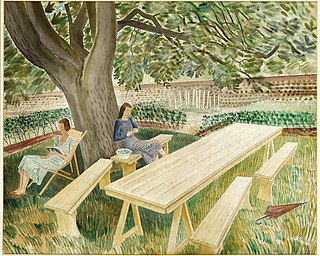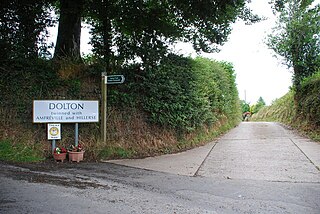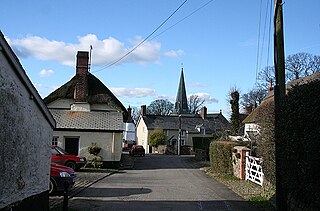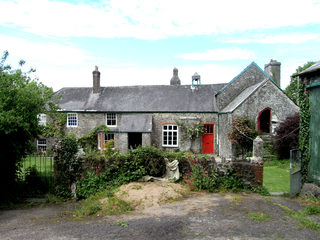Related Research Articles

Coltishall is a village on the River Bure, west of Wroxham, in the English county of Norfolk. The village is located within the Norfolk Broads.

Moretonhampstead is a market town, parish and ancient manor in Devon, situated on the north-eastern edge of Dartmoor, within the Dartmoor National Park. The parish now includes the hamlet of Doccombe, and it is surrounded clockwise from the north by the parishes of Drewsteignton, Dunsford, Bridford, Bovey Tracey, Lustleigh, North Bovey and Chagford.
The village of Hartland, whose parish incorporates the hamlet of Stoke to the west and the village of Meddon in the south, is the most north-westerly settlement in the county of Devon, England.

The New Forest is one of the largest remaining tracts of unenclosed pasture land, heathland and forest in Southern England, covering southwest Hampshire and southeast Wiltshire. It was proclaimed a royal forest by William the Conqueror, featuring in the Domesday Book.

Willington is a village and civil parish in the South Derbyshire district of Derbyshire, England. The 2001 Census recorded a parish population of 2,604, increasing to 2,862 at the 2011 Census.

James Ravilious, was a British photographer, who specialised in recording the rural life of north Devon.

Eric William Ravilious was a British painter, designer, book illustrator and wood-engraver. He grew up in Sussex, and is particularly known for his watercolours of the South Downs, Castle Hedingham and other English landscapes, which examine English landscape and vernacular art with an off-kilter, modernist sensibility and clarity. He served as a war artist, and was the first British war artist to die on active service in World War II when the aircraft he was in was lost off Iceland.

Dolton is a small village and civil parish in the Torridge district of Devon, south-west England, surrounded, clockwise from the north, by Beaford, Ashreigney, Winkleigh, Dowland, Meeth, Huish and Merton. It has a population of around 900.

Bovey Tracey is a town and civil parish in Devon, England, on the edge of Dartmoor, its proximity to which gives rise to the slogan used on the town's boundary signs, "The Gateway to the Moor". It is often known locally as "Bovey". It is about 10 miles south-west of Exeter and lies on the A382 road, about halfway between Newton Abbot and Moretonhampstead. The village is at the centre of the electoral ward of Bovey. At the 2011 census the population of this ward was 7,721.

Modbury is a large village, ecclesiastical parish, civil parish and former manor situated in the South Hams district of the county of Devon in England. Today due to its large size it is generally referred to as a "town" although the parish council has not elected to give itself the status of a town as it could do under s.245(6) of the Local Government Act 1972, so it does not have a town council and cannot have a town mayor. It is also known informally as a "market town", as from at least 1199 the lord of the manor has held the right to hold a regular market. The village is situated on the A379 road, which links it to Plymouth and Kingsbridge. The current parish population is approximately 1,500.

Holnicote in the parish of Selworthy, West Somerset, England, is a historic estate consisting of 12,420 acres of land, much situated within the Exmoor National Park.

Chulmleigh is a small Saxon hilltop market town and civil parish located in North Devon in the heart of the English county of Devon. It is located 20 miles (32 km) north west of Exeter, just north of the Mid Devon boundary, linked by the A377 and B3096 roads.
Beaford Arts is an arts organisation in Devon, England. It was established as The Beaford Centre in 1966 by John Lane for the Dartington Hall Trust. It promotes and supports the arts in rural north Devon - an area of 799 square miles bounded by Dartmoor, Exmoor, and the Atlantic west coast.

Knowstone is a village and civil parish situated in the North Devon district of Devon, England, halfway between the Mid Devon town of Tiverton, Devon and the North Devon town of South Molton. The hamlet of East Knowstone lies due east of the village. Knowstone was the birthplace of Admiral Sir John Berry (1635–1691), second son of Rev. Daniel Berry (1609–1654), vicar of Knowstone cum Molland. An elaborate mural monument erected by Sir John in 1684 to the memory of his parents survives in Molland Church.

Swimbridge is a village, parish and former manor in Devon, England. It is situated 4 miles (6.4 km) south-east of Barnstaple and twinned with the town of St.Honorine Du Fay in Normandy, France. It was the home of the Rev. John "Jack" Russell who first bred the Jack Russell Terrier.

Karpatiosorbus devoniensis is known by the English name of Devon whitebeam and formally as Broad-leaved Whitebeam. When the fruit was reported as sold at Barnstaple Pannier Market the name French Eagles was used, apart from 1929 when they were reported as eagle-berries. When the trees were reported as seen growing wild on botanical walks they were referred to as French Hails. Broad-leaved white-beam, which was the common name until Devon Whitebeam took over, was used once in 1907.

King's Nympton is a village, parish and former manor in the North Devon district, in Devon, England, in the heart of the rolling countryside between Exmoor and Dartmoor, some 4½ miles (7 km) S.S.W. of South Molton and 4 miles (6 km) N. of Chulmleigh. The parish exceeds 5,500 acres (2,226 ha) in area and sits mostly on a promontory above the River Mole which forms nearly half of its parish boundary. In 2021 the parish had a population of 444.

Woolleigh is an historic estate in the parish of Beaford, Devon. The surviving mansion house known as Woolleigh Barton, situated 1 3/4 miles north-west of the parish church of Beaford, is a grade II* listed building, long used as a farmhouse. It incorporates remains of a "very fine example of a late Medieval manor house" and retains a "very rich" 15th century wagon roof, a garderobe with the original door, and an attached private chapel with a 17th-century roof.

Robert Bastard (fl.1086) was a Norman warrior who assisted in the 1066 Norman Conquest of England under King William the Conqueror. He was subsequently rewarded with landholdings in Devonshire and is one of the Devon Domesday Book tenants-in-chief of that monarch, with a holding of 10 manors or estates held in chief, 8 of which he held in demesne, i.e. under his own management without tenants. He had at least one further holding as a mesne tenant, at Goosewell, Plymstock parish, Plympton hundred, held from William of Poilley, a Norman tenant-in-chief from Poilley in Normandy, most of whose 21 landholdings were later granted by King Henry I (1100–1135) to his trusted supporter Richard de Redvers, feudal baron of Plympton in Devon.
Barbara Dolignon "Jill" Furse was an English actress.
References
- 1 2 "Last Name Meanings and Origins | Search Surnames at". Ancestry.com. Retrieved 24 April 2015.
- ↑ Optix Solutions Ltd 2010. "Devon Wildlife Trust". devonwildlifetrust.org.
{{cite web}}: CS1 maint: numeric names: authors list (link) - 1 2 Burke's Landed Gentry, 18th edition, ed. Peter Townend (Burke's Peerage Limited - 1965), Furse of Halsdon - p. 295
- ↑ The Church of Jesus Christ of Latter-Day Saints, International Genealogical Index (Internet Version) (Copyright 1999-2002), Parish Records of Stockleigh English, Devon
- ↑ Visitations to the county of Devon (the 1531, 1564, & 1620 editions.)
- ↑ "Discovery - The National Archives". a2a.org.uk.
- ↑ "Discovery - The National Archives". a2a.org.uk.
- ↑ "Discovery - The National Archives". a2a.org.uk.
- ↑ "Halsdon Arabians". halsdonarabians.com.
- ↑ Optix Solutions Ltd 2010. "Devon Wildlife Trust". devonwildlifetrust.org.
{{cite web}}: CS1 maint: numeric names: authors list (link) - ↑ James Ravilious. "Photographer of rural life 1939 - 1999, photographs of Devon". James Ravilious. Retrieved 24 April 2015.
- ↑ "BBC - Devon - In Pictures - James Ravilious Photographs". bbc.co.uk.
- ↑ "Beaford Archive : About Beaford Archive". beaford-archive.org.uk.